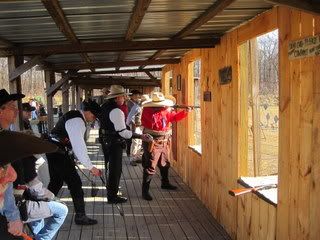

 The Accurate Reloading Forums
The Accurate Reloading Forums  THE ACCURATE RELOADING.COM FORUMS
THE ACCURATE RELOADING.COM FORUMS  Guns, Politics, Gunsmithing & Reloading
Guns, Politics, Gunsmithing & Reloading  Reloading
Reloading  Gunpowder deterioration risk
Gunpowder deterioration riskGo  | New  | Find  | Notify  | Tools  | Reply  |  |
| One of Us |
Many of us store considerable quantities of gunpowder. Most of the loading manuals and other sources of handloading information caution against the dangers of deteriorated powder. While reports surface occasionally (see the Sept 2007 issue of Precision Shooting) I have not encountered this problem (that I know of) and my understanding of the risk has been rather dim. I've simply not been too concerned with it, believing the manufacturers' line that gunpowder of modern manufacture has an indefinite shelf life. Not so, it seems. Those of similar belief should do themselves a favor by reading the article, "Propellant Stability and Safety" in Ammunition Quarterly 36, published by the Marine Corps Systems Command. An on-line version (PDF) appears at this link. Once the PDF loads, scroll down to the article begining on page 7. The article describes the causes of propellant deterioration and describes seven autoignition (spontaneous combustion) events in Army magazines during the period 1984 through 1997. All these accidents involved nitrocellulose propellants, but of particular interest is the following: "IMR powder that was only 5 years old autoignited; the above ground magazine & its contents were destroyed. More than 100,000 lbs of powder deflagrated." "The same lot of IMR powder, a fragment quantity was isolated and saved for critical production testing, auto-ignited two months after the previous fire. Only a small quantity of powder was lost, but another magazine was destroyed." What this incident and the others suggest for my relatively measly stash is unclear, and I don't want to scare anyone. But I've got some powders dating back to the 1960s and I'm beginning to wonder how prudent it is to keep the older stuff around. Good luck, and good shooting. Jim | ||
|
| one of us |
Sorry, I would call BS on autignition of stored powder. If you store in original containers & keep them away from flame & spark, in a reasonably controled environment, I can see powder lasting beyond 30yrs w/o problems. I have some that goes back 20 now & is still useable. LIFE IS NOT A SPECTATOR'S SPORT! | |||
|
| One of Us |
I didn't read it but it sounds like a chicken little thing to me. I've been storing powder in a cool, dark closet for 40 years w/o a prob. I've got worse problems to worry about. Like Hillary getting in the W/H. | |||
|
one of us |
+1 with stillbeeman | |||
|
| one of us |
i had some WWII 4831 go bad after I had it about 3 or 4 years. That was about 1985. So it was at least 40 years old. When you start smelling nitic acid get rid of it. The only other IMR I have seen with a problem was 4320. Back in the late 80 it seemed that every can of it rusted out. | |||
|
| one of us |
As with any information propagated by a military source, I would have substantial doubts about this seemingly "spontaneous combustion". Sounds like the usual CYA report to obscure somebody's f*#k up. Don't you wonder why this has only been reported with military powder stocks? Hmmmm. . . | |||
|
| One of Us |
Who and What nonsense have they been ingesting !. Deterioration of Primers and powders occur from three sources . First EXCESSIVE HEAT or EXCESSIVE MOISTURE last but not least CONTAMINATION !.Period . I have some powders which are in excess of 40 years old which still produce decent groupings as well as respectable velocity numbers . How ever they have always been properly stored and are in their original containers , which also show NO SIGNS of defects . I how ever discourage ANYONE from storing Excessive amounts of powder or keeping powders longer than 5-10 years . Exceptions to the above rule are Discontinued powders which WORK for your applications , then properly store it and USE IT !. Many years ago I worked for Hercules Powder Company and Dupont , manufacturing Explosives . Shoot Straight Know Your Target . ... | |||
|
| Powered by Social Strata |
| Please Wait. Your request is being processed... |
|
 The Accurate Reloading Forums
The Accurate Reloading Forums  THE ACCURATE RELOADING.COM FORUMS
THE ACCURATE RELOADING.COM FORUMS  Guns, Politics, Gunsmithing & Reloading
Guns, Politics, Gunsmithing & Reloading  Reloading
Reloading  Gunpowder deterioration risk
Gunpowder deterioration risk

Visit our on-line store for AR Memorabilia

